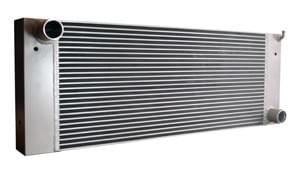Introduction
What is a Heat Exchanger?
A heat exchanger is a device that facilitates the transfer of heat between two different media. For example, a hydraulic oil cooler uses cold water or air to remove heat from hot oil. Similarly, a swimming pool heat exchanger employs hot water from a boiler or solar hot water loop to heat the pool water. Heat conduction occurs through the exchanger material, which separates the two media. In shell and tube heat exchangers, fluids flow through and around tubes, while in air - cooled heat exchangers, cold air passes through a finned core to cool the liquid.
Types of Heat Exchangers

- Plate Heat Exchangers: Operate similarly to shell and tube exchangers but use a series of stacked plates instead of tubes. They are often brazed or sealed depending on the application and fluids used. Their compact stainless - steel structure makes them ideal for use with refrigerants or in food and beverage processing.

- Air - cooled Heat Exchangers: Commonly used in vehicles or other mobile applications where a permanent cold water source is unavailable. We design and supply combined cooling assemblies (or combined coolers) that integrate the engine jacket water cooler, oil cooler, and charge air cooler into a single unit, reducing space requirements and increasing efficiency. Cold air is provided by a fan or the airflow generated by the vehicle's movement.

Designing a Heat Exchanger
- Design Considerations: To select an appropriate heat exchanger, we need to know the fluid type, temperature, and flow rate of the primary loop (usually the hot fluid), the desired heat removal or target outlet temperature from the primary loop, and the fluid type, temperature, and flow rate of the secondary loop (usually the coolant). Additionally, any pressure loss limitations and other special requirements should be considered. You can download our heat exchanger data sheet template, which highlights the essential fields for heat exchanger selection.
- Marine Heat Exchangers: Marine heat exchangers operate similarly to freshwater coolers, but they must be designed to resist seawater erosion and corrosion. Materials such as 90/10 copper - nickel alloy, 70/30 copper - nickel alloy, bronze, and titanium are suitable for contact with seawater. Other factors like flow velocity need to be considered. If the velocity is too low, there is a risk of sand and other particles clogging the pipes, and if it's too high, the tube sheets and tubes can corrode rapidly. Sacrificial anodes can be installed for added protection.
- Suitable Fluids: The compatibility of fluids with a heat exchanger depends on the exchanger type and available materials. Standard heat exchangers are suitable for most fluids, including oil, water, glycol, and seawater. For more corrosive fluids like chlorinated brine, refrigerants, and acids, other materials like stainless steel and titanium are required.
- Temperature Cross: Temperature cross occurs when the temperatures of the two loops in a liquid - cooled heat exchanger start to cross. This can significantly reduce the cooler's efficiency. In many cases, plate heat exchangers are the best choice for applications where temperature cross changes cannot be avoided.
- Heat Exchanger "Passes": A pass refers to the movement of a fluid from one end of the exchanger to the other. For example, in a "straight - through tube" circuit (usually the coolant): a single pass means the fluid enters at one end and exits at the other; a double pass means the fluid enters and exits at the same end; a triple pass means the fluid travels three times along the length of the exchanger body before leaving. More passes increase the heat transfer but also lead to higher pressure losses and velocities. With complete operating data, we can select the most efficient heat exchanger while working within pressure loss and velocity limits.
- Flow Rate: Larger flow rates increase the heat transfer capacity but can also make energy removal more difficult and increase speed and pressure losses.
- Installation: Heat exchangers should be installed according to the manufacturer's guidelines. The most efficient installation method is usually with counter - current flow (if the coolant flows from left to right, the hot fluid should flow from right to left). For shell and tube exchangers, the coolant should enter at the lowest inlet position to ensure the exchanger is always full of water. For air - cooled exchangers, air flow should be considered during installation.
Conclusion
Heat exchangers are vital components in many systems, and understanding their types, design principles, and optimization methods is essential for efficient operation. Whether it's for industrial processes, marine applications, or other uses, choosing the right heat exchanger and implementing proper design and installation practices can lead to improved performance and energy savings.
